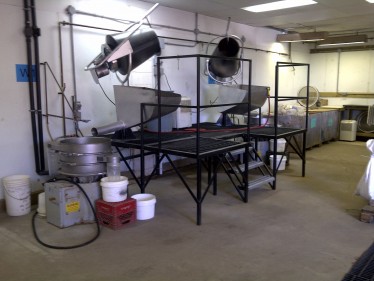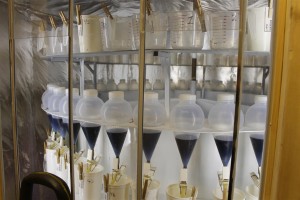KIM Laboratory
Our Kimberlite Indicator Processing Laboratory has a wide range of abilities and processes available.
Standard processing of a till sample would follow a combined desliming/wetscreening process (see picture). Our custom system uses a mixing device to agitate the sample in a slurry which is next sent to a wetscreening unit which does an initial sizing of the sample. This system is designed so that none of the desired material is lost when removing the water from the slurry. A typical till would be sized in our wetlab at a bottom cutoff of 0.25mm and a top cutoff of 1.0mm. Standard processing of a till sample would follow a combined desliming/wetscreening process (see picture). This process involves using a modified cement mixer to turn the sample into a slurry in order to pour the sample over the wetscreen unit. By creating a slurry the sample is able to be cleaned much more efficiently and removes much of the ultrafine materials such as silts. Once the sample has been put through the mixer it is poured into a hopper which then directs the sample to the wetscreen which further cleans the materials and sizes it to the desired fractions.
which does an initial sizing of the sample. This system is designed so that none of the desired material is lost when removing the water from the slurry. A typical till would be sized in our wetlab at a bottom cutoff of 0.25mm and a top cutoff of 1.0mm. Standard processing of a till sample would follow a combined desliming/wetscreening process (see picture). This process involves using a modified cement mixer to turn the sample into a slurry in order to pour the sample over the wetscreen unit. By creating a slurry the sample is able to be cleaned much more efficiently and removes much of the ultrafine materials such as silts. Once the sample has been put through the mixer it is poured into a hopper which then directs the sample to the wetscreen which further cleans the materials and sizes it to the desired fractions.
After the sample has been dried it is weighed and dry sieved to size the sample to the final fraction that will be processed through Heavy Liquids. Sizing of the sample can be at any number of combinations most notably 0.063mm, 0.125mm, 0.18mm, 0.25mm, 0.425mm, 0.5mm and 1mm (with other sizes available). Following size classifications is a two stage liquid separation. Our initial Low Density liquid separation is set at a lower (2.9) s.g. using a non-toxic liquid called LST (Lithium Sodium Tungstates) to eliminate much of the bulk of reject material.
 Following our Low Density separation we use our custom High Density separation. Specific gravity in our High Density separations can range from 3.1 to 3.45. Typically, on most samples we use a s.g. of 3.35 to create a very small concentrate (when compared to traditional methods). Using our process we are able to achieve a higher density than that of other liquids such as MI (typically only achieve as high as 3.3 s.g.). The result is a much smaller concentrate which can realize substantial savings on observation costs.
Following our Low Density separation we use our custom High Density separation. Specific gravity in our High Density separations can range from 3.1 to 3.45. Typically, on most samples we use a s.g. of 3.35 to create a very small concentrate (when compared to traditional methods). Using our process we are able to achieve a higher density than that of other liquids such as MI (typically only achieve as high as 3.3 s.g.). The result is a much smaller concentrate which can realize substantial savings on observation costs.
In addition to the methods listed above we have the ability to use other processes on the sample depending on the clients needs including the use of a wilfley table or magnetic separation. We have tailored our system to use a process that achieves the best final result while limiting the handling required of the sample so the client is assured of the integrity of the results.

